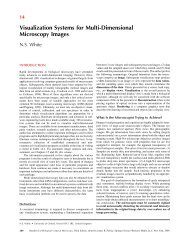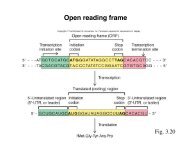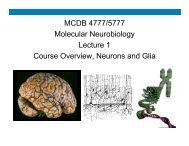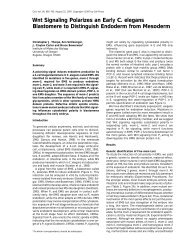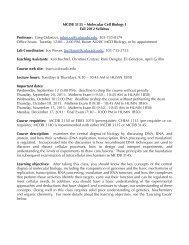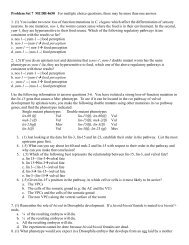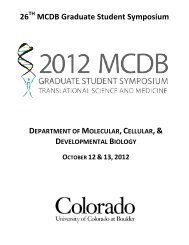Lecture 3: A Brief Overview of Molecular Phylogeny - MCD Biology
Lecture 3: A Brief Overview of Molecular Phylogeny - MCD Biology
Lecture 3: A Brief Overview of Molecular Phylogeny - MCD Biology
Create successful ePaper yourself
Turn your PDF publications into a flip-book with our unique Google optimized e-Paper software.
8<br />
1 ml E.coli at 5x10 8 /ml.<br />
20 ml phage at 2.5x10 10 /ml<br />
- What portion <strong>of</strong> the bacteria are infected with exactly one phage?<br />
Two phage? Three phage?<br />
- What portion <strong>of</strong> the bacteria are uninfected? (I.e., what is P(0). Remember here that, by convention,<br />
n 0 = 1 and 0! = 1.), so<br />
P(0) = e -m<br />
Continuing with the experiment, you dilute the infected culture so that when you put 100 ml into different wells <strong>of</strong> a<br />
multiple-well plate you are putting, on<br />
average (m) , one bacterial cell per well; you will incubate to lysis and then assay the number <strong>of</strong> phage in the<br />
indvidual wells to extract burst-size. In the distribution into wells:<br />
- What fraction <strong>of</strong> the wells gets exactly one cell?<br />
- What fraction <strong>of</strong> the wells gets one infected cell?<br />
Problem 2. What would the phage/bacterium ratio have to be so that exactly 95% <strong>of</strong> the bacteria are infected?<br />
Problem 3. You are engaged in a genome project, and are dancing between costs and maximum coverage. You<br />
choose a random approach. If you sequence single-pass (one sequence run on a one-strand genome equivalent)<br />
on your library, what would be the coverage (fraction nucleotides sequenced single-pass)?<br />
- How many passes for 95% double-strand coverage (a common goal)?<br />
Problem 4: Make-up and solve a problem using Poisson statistics.




